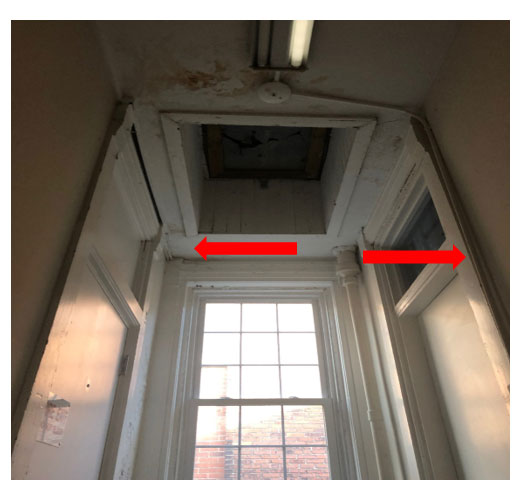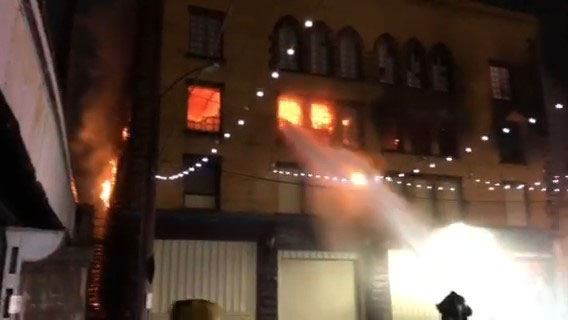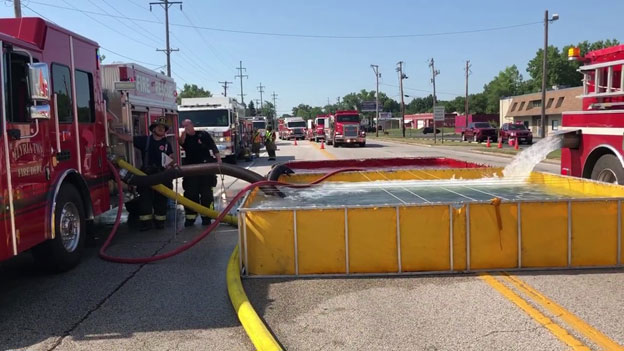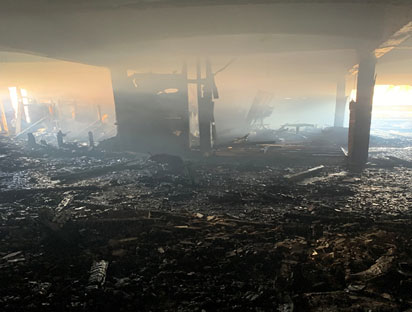Photos by author except where noted
In the previous article, we looked at five issues that firefighters must address when responding to fires in your legacy Main Street buildings.
Our education, rightfully so, speaks of the modern fire environment. This may mistakenly lead many younger firefighters into thinking that every environment will be of modern combustibles with faster heat release rates than are seen with legacy furnishings. It may also make one focus solely on modern construction and the hazards associated with it.
Below are another five quick reminders on some building construction elements to be aware of when responding to fires in your community’s downtown.
Transoms
A transom window is a window above a door that is usually hinged to a horizontal crosspiece over the door to provide cross-ventilation while maintaining security and privacy, due to their small size and height above floor level. They were a typical feature of office buildings and apartments before air conditioning became common. These windows are usually still single pane glass and can fail under fire conditions. Their presence may be hidden by drop ceilings or wood coverings, which may be employed as energy conservation methods or for aesthetic reasons.
These windows may also be painted over or covered with some type of decorative material. Failing to identify the presence of a transom window can create problems such as allowing high heat and smoke to exit into common areas. Despite employing the correct strategy of controlling the door and flow path, missing the existence of these windows may critically affect the life safety of both firefighters and civilians in unprotected areas. It may also allow for rapid fire spread which is already a major concern in Type III ordinary constructed occupancies.
If you are aware of their existence and believe you have an active fire, you must consider rapidly changing conditions caused by their possible failure. Another reason to go in with a charged hoseline and a crew ready to attack fire!
The failure of transom windows contributed to a rapid fire spread at the Our Lady of Angels fire, which occurred in Chicago on December 1, 1958, and tragically took the lives of three teachers and 92 students. As noted in several after action reports, when this tragic fire was discovered, many of the teachers closed their doors to “shelter in place” and protect their students. The fire, which began in the basement and raced up the open stairwell, feeding off the combustible interior finish of the hallways, intensified and caused the transoms to break, thus allowing high heat and smoke into the classrooms.

Renovations
The key to getting ahead of fires in renovated Main Street buildings is twofold. First, become friendly with your city’s community development director and/or main street development group. See if one exists in your town, and if they do, ask them for a meeting to discuss what’s happening on your Main Street. The second key is one that sticks out like a sore thumb: a dumpster! When you see large dumpster and perhaps an orange trash chute from an upper floor of a Main Street building, stop and see if you can get some intel on what’s going on inside.
- Lessons from Downtown Fire in a Challenging Legacy Building
- Collapse Zones, Voids, and Sector Discipline at Large Fires
- Building Construction Review
Just recently I went through a building that was being rehabbed. The owner was putting in coolers in the basement of this downtown building. These were nothing more than large Styrofoam walls. If there is ever a fire in this building, the amount of smoke will be tremendous. It also represents a huge firefighter hazard if an unsuspecting firefighter crawls into one of these coolers.
Just because you don’t see current renovations going on in your downtown, don’t assume that a 100-year-old plus building hasn’t had some changes. Many buildings in your downtowns were built before modern heating, ventilation, and cooling (HVAC) technology was present. If they have been inhabited anytime since the 1950s you can make a pretty good assumption that there have been voids created by ductwork, etc.
Many downtowns have restaurants on the first floor of these legacy buildings. If these are in your district beware of cooking vents and shafts that may go through the upper floors of the building.
Void spaces are a massive issue when it comes to fire spread, The key is to know ahead of time where they may be, assume every building has them, and have your firefighters work on cutting the fire off.
Renovations can also occur on the exterior. One big item making its way on many Main Streets is the use of exterior lighting strung between buildings, i.e., Christmas lights all year round. A wise firefighter should check with someone in your city or downtown consortium to see how to deactivate or even remove them. Don’t bet that these lights are low voltage and “break away” easily, no matter how much proponents insist otherwise.


Residential Tactics on a Commercial Fire
Click here for an interview with Charles Hood, chief of San Antonio (TX) Fire Department, discussing the line-of-duty death of Firefighter Scott Deem in a commercial building. Chief Hood explains the mindset that perhaps effects many fire departments when responding to a commercial building fire.
A residential dwelling fire is a common fire that all departments respond to, it is very easy for an inexperienced chief or firefighter to do what they are comfortable with when arriving at the scene of a working fire in a legacy Main Street structure. These buildings will require a lot of staffing and a real strategic mindset if you truly want to stop the forward progress of the fire.
Sectoring, search, rapid intervention, apparatus spotting, and water supply are just a few items that need to be considered with a “can’t have enough” mentality. These fires tend to be a major drain on your staffing and water supplies. Even if you have a well-maintained, hydrated area in your downtown, you may want to review and establish plans on bringing in large water sources via water shuttles.

Fire Apparatus Spotting
You only get one chance to spot your apparatus correctly on a Main Street fire, and most small towns with only one or no aerial devices may get lost in the fog of the fireground and neglect to consider apparatus placement when attempting to protect exposures or cut off fire spread.
- Apparatus Placement
- Pressler: POSITIONING APPARATUS FOR SAFETY
- Firefighting Basics: Positioning Fire Apparatus, Part 1
Flanking the building corners is the common rule of thumb but during the firefight. Consideration must be given to apparatus placement in adjoining exposures and the use of large-caliber streams from aerial devices to cut off advancing fire.
When spotting apparatus on arrival, don’t look for where the visible fire is but rather where the fire is in the places you can’t see. Apparatus spotting can also be trained on prior to your event. Saturdays and Sunday mornings are excellent times to get your apparatus out on your Main Streets.

Water Use and Postfire Concerns
Many small-town fire departments know how to move water, especially if they cover rural areas not protected by hydrants. It’s the larger, mid-size departments like my own that lose track or fail to realize the amount of water needed when a Main Street fire occurs and covers a large area of conjoined buildings that require protection. Some quick rules of thumb to remember regarding water supply on Main Street:
- When you go with defensive streams, put the handlines down! Handlines cause two concerns on Main Street. First, they rob water for your master streams. Second, they tend to make your firefighters get too close and wander into collapse zones.
- Many Main Streets have one thing in common: regardless of area, they are old and under them are old water mains. These mains will be sorely taxed by a major fire operation. Don’t “rob” your pumping engines from each other by having them all hooked up to the same water main.
- If you’re a mid-size department that is surrounded by small departments that use tankers/tenders, etc. they no doubt use water shuttle tactics, perhaps employing large dump tanks that serve as drafting sites. Get to know and understand their capabilities and use them when your fire occurs. I recently attended a large fire in another city and was frustrated watching my tower apparatus flowing only one master stream when it can flow two at 1,000 gpm at a large commercial fire. If you don’t have the underground water capacity, go to the above ground kind! Be sure to know what your resources are.
Water Issues After the Fire
“There had been no sign of structural problems at Ebenezer Baptist Church before its steeple toppled as firefighters doused hot spots,” Fire Chief Peter Micheli said. That quote is from a March 13, 2004, fire in Pittsburgh that claimed the lives of two firefighters and injured many more. The collapse occurred approximately three-plus hours after arrival. Crews were operating defensively during that time and were inside checking for hot spots when the steeple crashed down into the basement.
On May 22, 2018, In York, Pennsylvania, two city firefighters were tragically killed when they were inside a 140-year-old mill complex that was being rehabbed to house apartments. The collapse occurred the day after the original multiple alarm fire. These firefighters were inside attending to hot spots, which are common when dealing with a fire of this magnitude.
These two tragedies and their lessons should be in our mind when we are operating at these large campaign fires which are common when you have a Main Street event. Thousands and sometimes millions of gallons flowing into a building create an enormous amount of weight and stress in addition to the obvious destruction caused by fire. It can be very easy to let your guard down as an incident commander. Don’t let your exhaustion get the best of you. We all love arriving at a working fire, especially one in a commercial building, but the longer you go defensive, especially during inclement weather, the more you “just want to get done.”
Always consider the danger and the fact that the building may just smolder for days after the fact. The safest thing you can do is pour water, even if it is just for the “aesthetic effect” to your city fathers. Another factor on Main Street is the desire for members of the community and the building owner to get inside to salvage historic artifacts. As stated before, these buildings can hold a real historic and family-like value/feel to your town. Always continue to size up and monitor conditions before entering a ravaged commercial building. It may be best to bring in heavy equipment and tactically dismantle as you flow master streams.

Battling a Main Street fire will be a challenge. If you are prepared mentally and tactically through discipline and training, your success may not show with saving the original fire building but more so on what you save surrounding the structure. It is on you to decide how you and your department will viewed by your city officials and citizens after the event, and most importantly in keeping yourself and fellow firefighters safe.
Joseph Pronesti is a 33-year veteran of the city of Elyria (OH) Fire Department. He is a frequent contributor to Fire Engineering and serves as the chief of department. He will be presenting the preconference workshop Main Street Fires 2022 at FDIC International in April of 2022.

